Why Your Grandmother Would Tell You to Buy Indy Pass
What the rise of the day pass tells us about Indy Exceptionalism
Yesterday I paid $101 for two bags of groceries. For like three boxes of cereal and a bunch of berries and vegetables and two tubs of hummus and a couple pounds of whitefish. I was disappointed by this but also resigned to it. Because I know there’s a better way but also because I’ll never locate it. Like there’s probably a Grocery Gangsters app with octuple coupons and a trick to get half off your entire order if you type the Pledge of Allegiance backward into the credit card machine. But for me it’s a personal achievement to do anything other than sit here writing about snosportskiing and if I tried to become a grocery ninja it would become a big life problem. So I’ll just keep being dumb about food even though I need it every day.
Over the past decade, American lift-served skiing has become a lot like a grocery store. There are lots of coupons and lots of hacks, but they’re usually not available upon arrival. To ski for cheap, and to ski a lot, you need to think ahead. You can’t be your divorced Uncle Gary, loading up a shopping cart with Stroh’s and frozen pizzas in a post-bowling league quick stop. You need to be more like Grandma Mildred, clipping coupons (with scissors) from the Sunday paper (printed on paper), and go stand in line for the actual cashier, because who understands those robot checkout machines anyway?
Sort of by accident, and at the expense of understanding anything of actual value to greater society, I have become the Grandma Mildred of American lift-served skiing. Or at least her enabler. Because if you printed all my Big Dumb Charts in the Sunday circulars, your grandmother would leaf through pages, cut out the Indy Pass coupon, seal it in an envelope, and mail it to you with a handwritten note saying, “if you don’t buy this ski pass, you’re a dumbass. At least if you want to ski more than a few days. Here’s a birthday check for $5 to get you started. Love you, Cupcake. Please visit.”
Grandma Mildred came to this conclusion because Indy:
Is the least-expensive truly national multimountain ski pass;
Delivers access to more ski areas in nearly every region, domestically and abroad, than every other national pass combined;
Has collected some truly standout destinations that in most regions rival anything on Epic and Ikon, especially in New England, the Mid-Atlantic, the Midwest, and the Upper Rockies;
Has built this sprawling empire almost completely outside of skiing’s mainline bazaar of Colorado I-70/the Wasatch/Tahoe, freeing the ski day from the immense tandem pressures of traffic on the roads and traffic on the bump;
And is in most cases a far better value than operators’ multiplying day-pass products, whose price structures only underscore what an incredible value Indy is.
The trickiest part of this analysis is that Indy’s sales period is extremely limited. But the pass is on sale now. Here’s a deeper look at Grandma Mildred’s coupon conclusions, and why Indy is maybe your best pass option for the 2025-26 winter:
1) Price
Well this one’s easy. Indy is cheaper than everything else:
Like, a lot cheaper. Check out the same chart with percent differences to Indy added:
But where the Indy Value really stacks is if you’re buying for multiples. Here’s the check-out cart total for your standard family of two adults, two kids 12 or younger:
The strangest part of this pricing dynamic is that Indy is loaded with far more choice than Epic, Ikon, or Mountain Collective, even if you assemble all their rosters into one.
2) Choice
I mean dang:
Indy’s partner advantage holds across every region other than the Southern Hemisphere, where the pass has only signed one ski area, in Chile:
I’ll admit my bias here. I’ve always been a resort-hopper. This is especially fun with kids, as the variety of new places challenges them and makes skiing low-level terrain more interesting for bros of us who are accustomed to JUST SLAYING IT. But I’ve also never really lived convenient to any one ski area – everything is a couple hours away. What Indy has done is collect enough variety that skiers living in nearly any U.S. cold-weather city sit within two to three hours of at least half a dozen partners and also have legitimate regional destination options for longer trips. If you live, for example, in Boston, Indy gets you on the lift at more than two-dozen drive-to options, from humble Pats Peak to lights-out Jay Peak:
The same is true if you live in the under-appreciated but rich Upper Midwest ski region:
Or the Upper Rockies/Pacific Northwest:
Or Canada:
Or almost anywhere outside of North America:
But we all know that nine pennies doesn’t equal a dime, even though they take up a lot more space. So what’s behind those Indy numbers?
3) Quality
Indy largely lacks skiing’s marquee brand names, especially in the western U.S. And Cadillacs cost more than Chevys for a reason, right? Sure, from the qualitative metric of how impressed your college roommate will be when you report that you skied Brundage (Indy) over Sun Valley (Ikon), the latter holds a lot more name recognition and cultural cache, not to mention better infrastructure. But to extend the metaphor, Malibus get you to all the same parking lots as Escalades, and a good ski day often has more to do with conditions and skier-volumes than anything else. And 1,920-acre Brundage, just slightly smaller than 2,533-acre Bald Mountain at Sun Valley, averages 293 inches per winter to the more famous mountain’s 193, and historically records around 25 percent of the total skier visits.
Spectacular, up-and-coming Brundage is something of an exception in the West, but not an absolute one. Epic, and then Ikon, stormed the West before Indy even hatched in 2019, and the duo locked down most of the big names in the process, especially in Colorado, Utah, and California. But, preoccupied with status and brand, they left a lot of large but less developed mountains off. Indy quietly collected these, leaving skiers with some really solid low-key destination options. A state-by-state stats comparison can nudge you toward some fabulous lesser-known mountains:
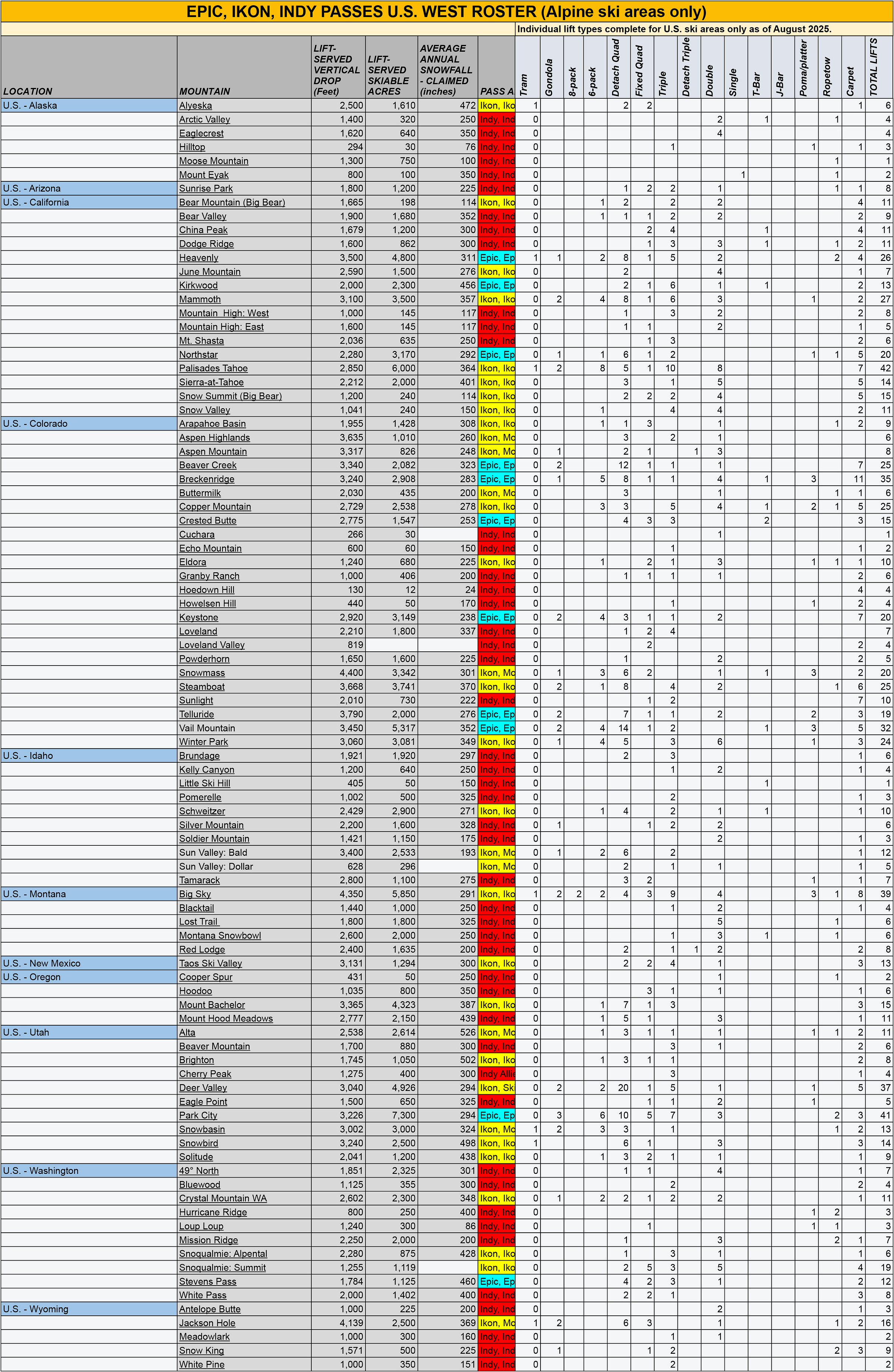
The offerings in Montana, Idaho, Washington, and Oregon, where Epkon’s presence is limited, are especially compelling. Indy stacks up even more favorably in the East, which is home to a lot more mountains bunched, in general, more densely:
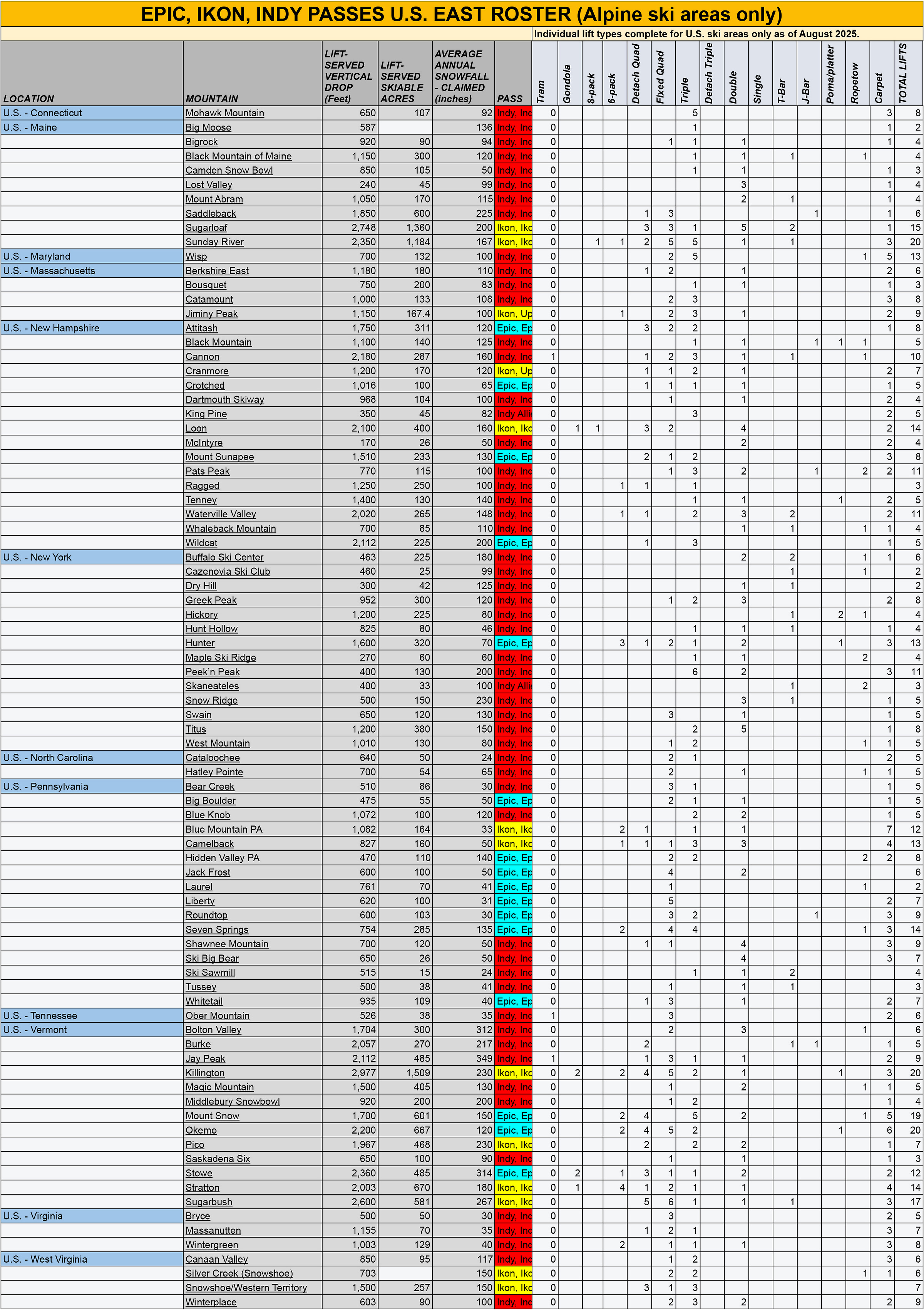
There are a million ways to further break this apart. But the point is this: if you want a pass with big-time skiing, you’re not sacrificing that requirement for a bargain. You’re just going to have to do a little more Reesearch.
4) Experience
Here’s an amazing stat: 61 percent (228) of America’s 375 public ski areas with a chairlift have joined Epic, Ikon, or Indy. And 141 of those 228 ski areas (62 percent) are on Indy Pass.
The asterisk, of course, is that some of these Indy Pass ski areas are small, underwhelming, hard to access, or intermittently open. But many are big, modern, well-maintained, and easy to get to. You cannot find an easier-to-access major ski area than 2,200-vertical-foot, 1,600-acre Silver Mountain, which hugs Interstate 90 in northern Idaho (and averages 328 inches of snow per winter – more than Beaver Creek, Heavenly, or A-Basin). Waterville Valley and Cannon, two of New Hampshire’s top ski areas, sit a short, easy drive off Interstate 93. Mount Hood Meadows is busy but big and built-out, and is close enough to under-visited snowtraps White Pass and Hoodoo to make a fun little alt-ski trip.
And there’s this: with the exception of regional icons like Meadows or Jay Peak, a lot of these big-acre ski areas draw far fewer skier visits than their Epkon competitors. Skier-visit numbers are scarce in our modern era, but historic data suggests that crowds are far thinner at typical Indy ski areas than at their more famous competitors. Check out Montana skier visits over the 2017-18 ski season (current Indy partners in red, Ikon in yellow):
Big Sky is a special place, huge and sprawling, laced with the nation’s most hyper-modern lift fleet. And it’s not particularly crowded. But Indy provides some compelling alternatives that are even less crowded and, beyond the lift ticket calculus, far less expensive in just about every way.
5) Value by day
There is of course this: Indy, unlike Epic or Ikon, does not offer unlimited access to any mountains. Skiers get two days at each partner, and that’s it. Like Mountain Collective, Indy occupies a strange place between full season pass and the large operators’ day passes. To appreciate Indy’s value, then, it’s more appropriate to compare the product to the large operators’ multiplying limited-days passes. And there’s really no comparison – the blue lines represent each products’ price, and the red line is the per-day price:
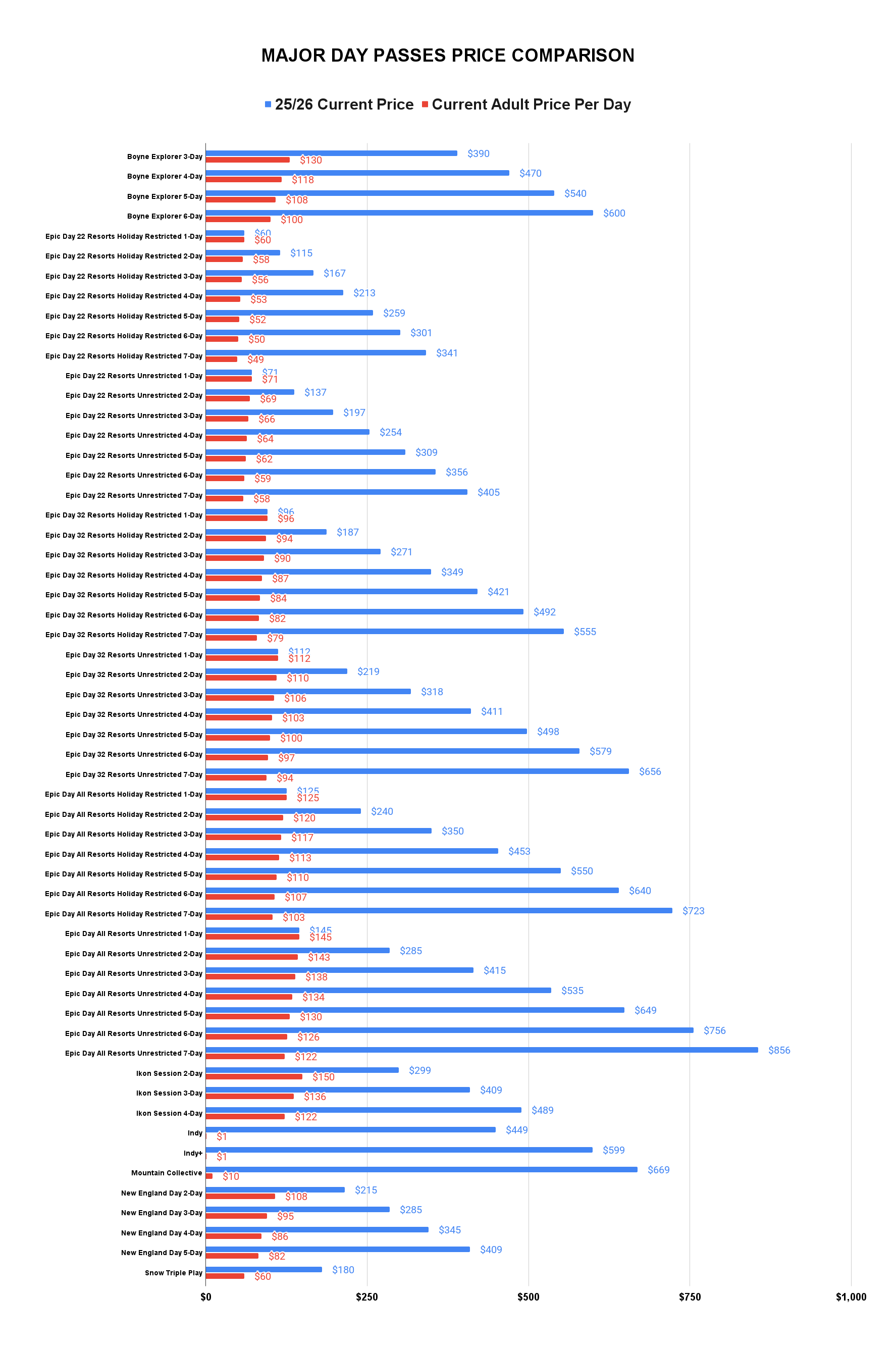
Indy costs just a touch more than three-day versions of most national pass products – with essentially unlimited possible days. While maxing out Indy is unlikely (in fact, impossible, as passholders are limited to one redemption per day), we don’t have to scale very far down the per-days usage cost to calculate Indy’s value compared to an Epic or Ikon day pass:
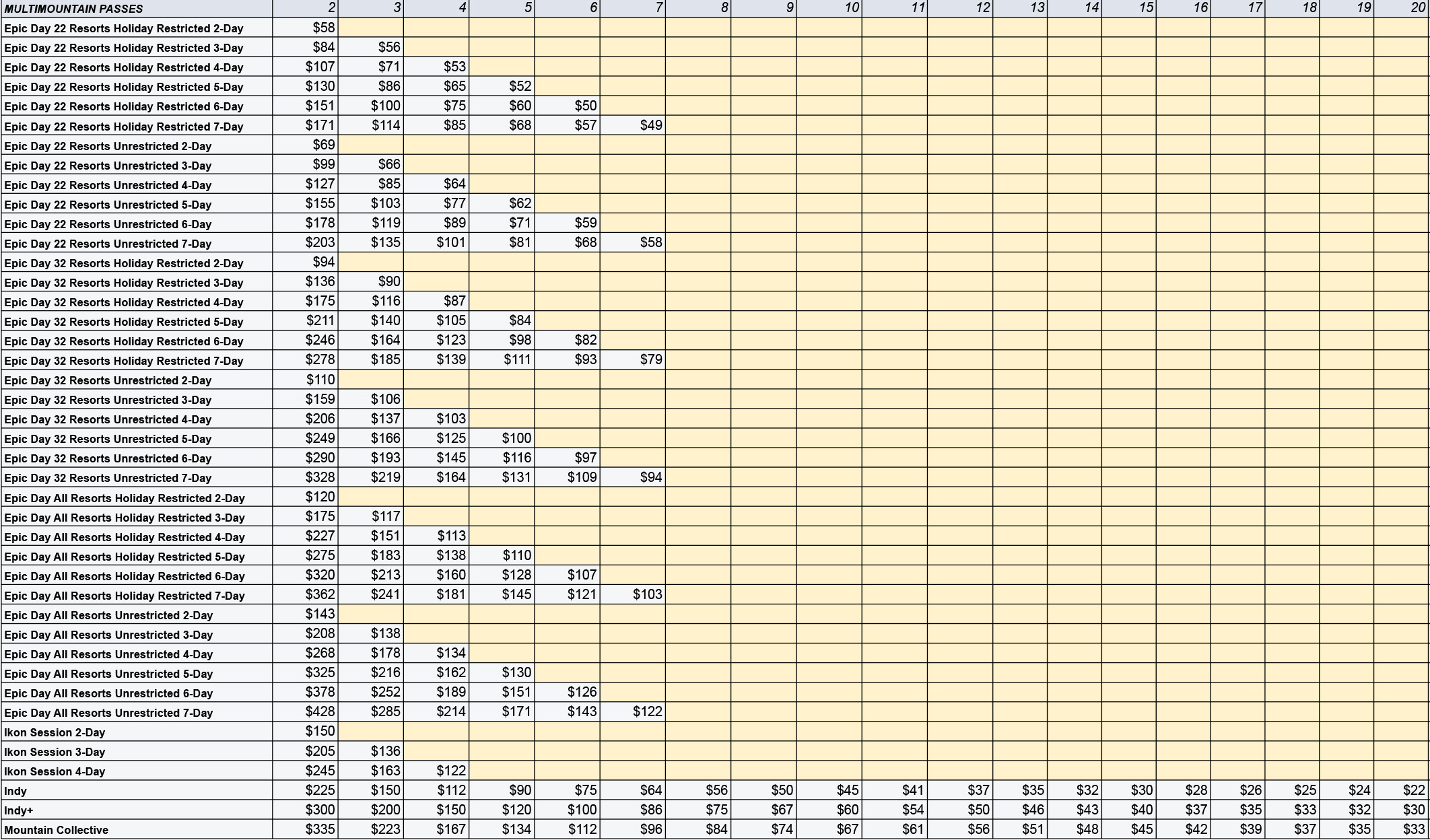
Pretty amazing. Mountain Collective too, especially considering it includes many of the ski areas left off Ikon Session: Alta, Snowbird, Snowbasin, Sun Valley, Aspen, and Jackson Hole.
The day passes are, overall, still a good value compared to lift tickets, and I’ll have more to say on these soon. But the proliferation of these products only underscores how incredible of a value Indy Pass is.


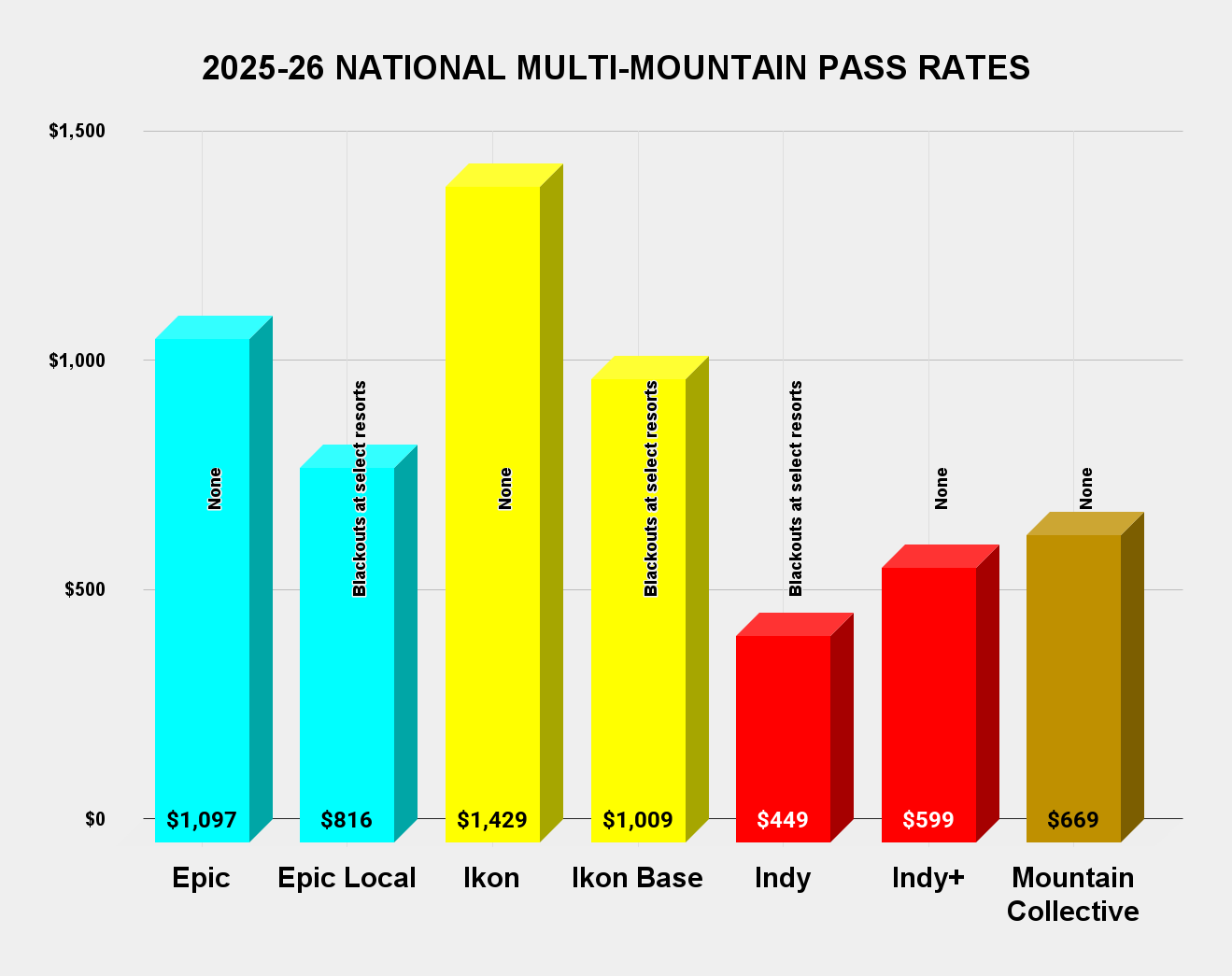
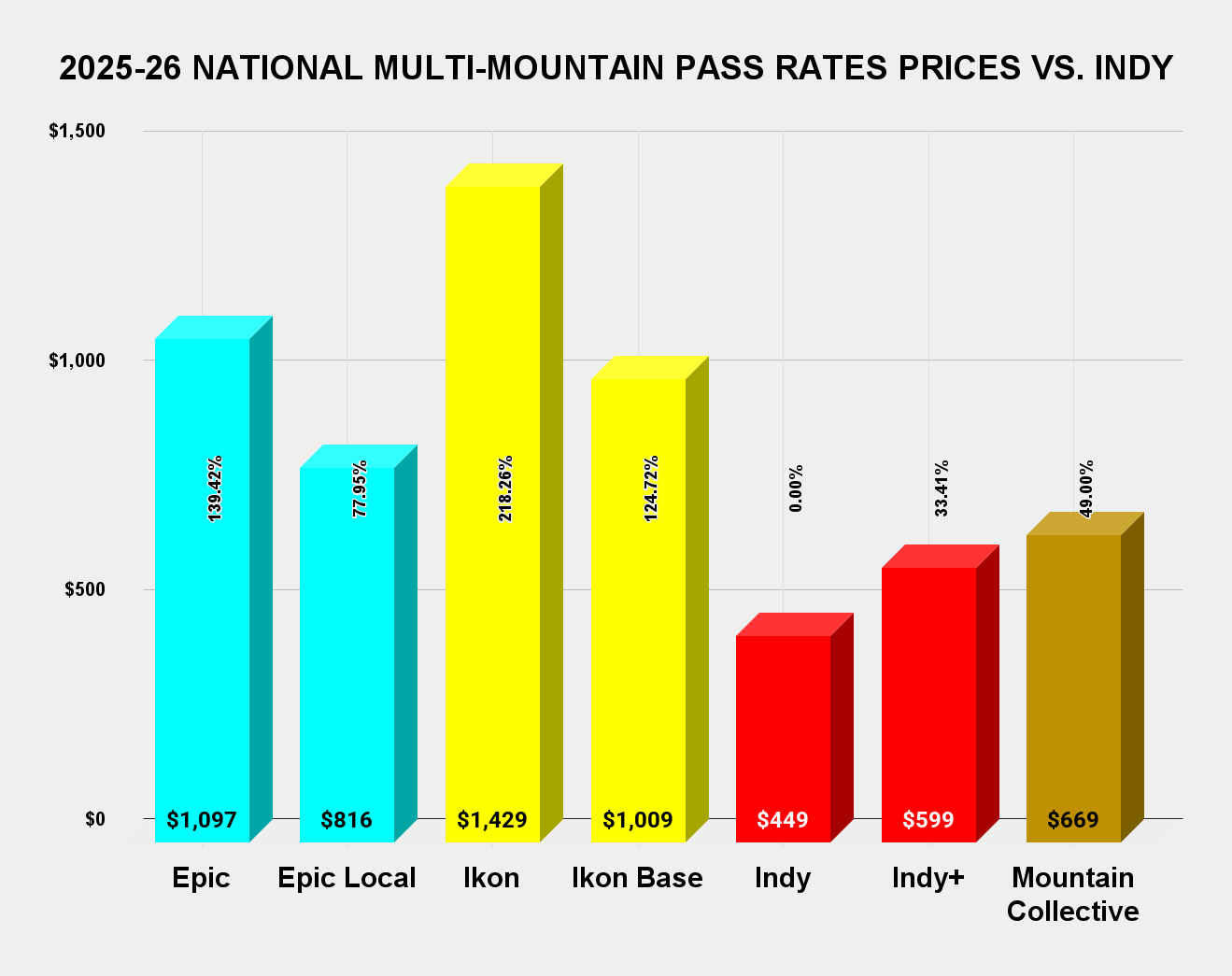
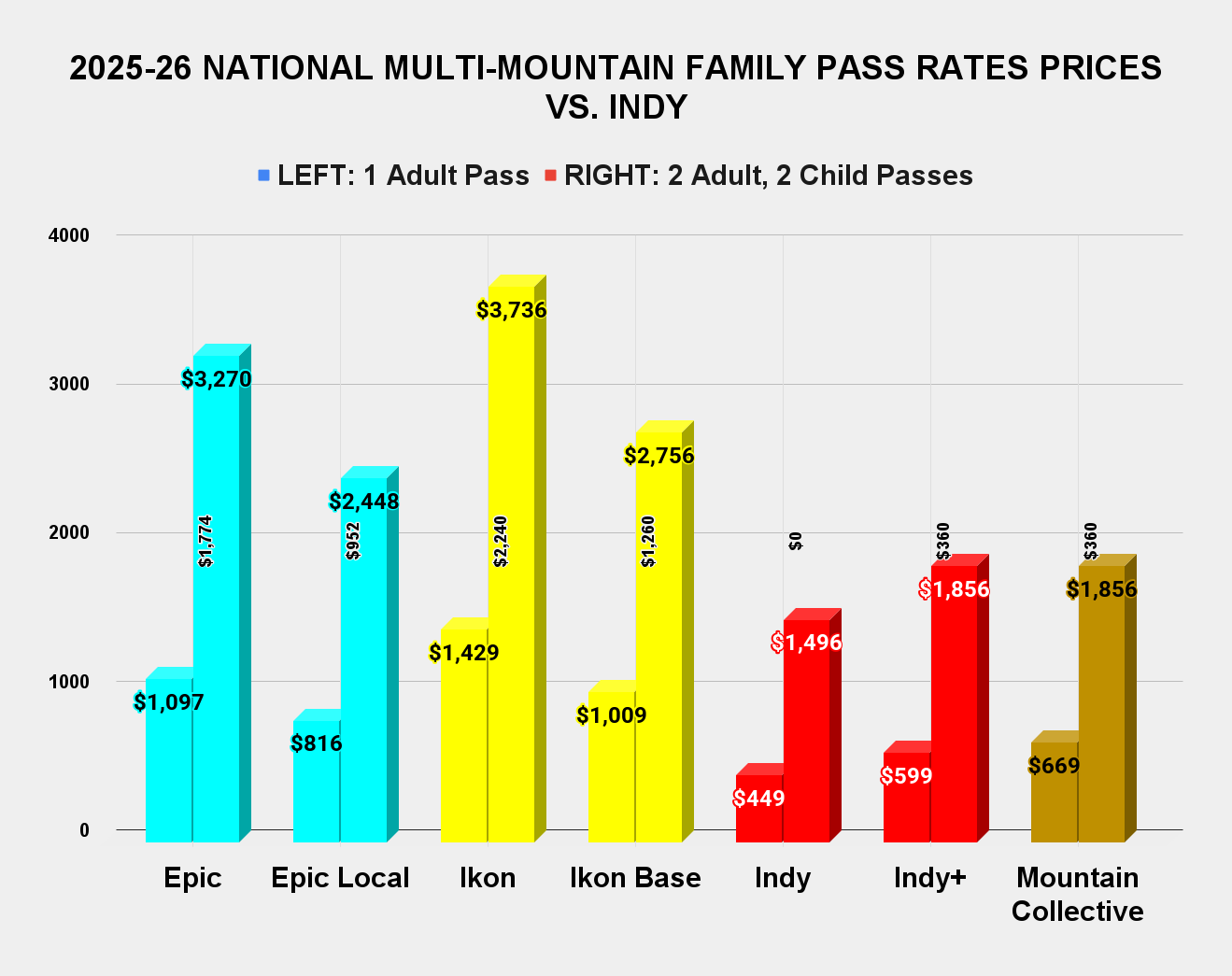
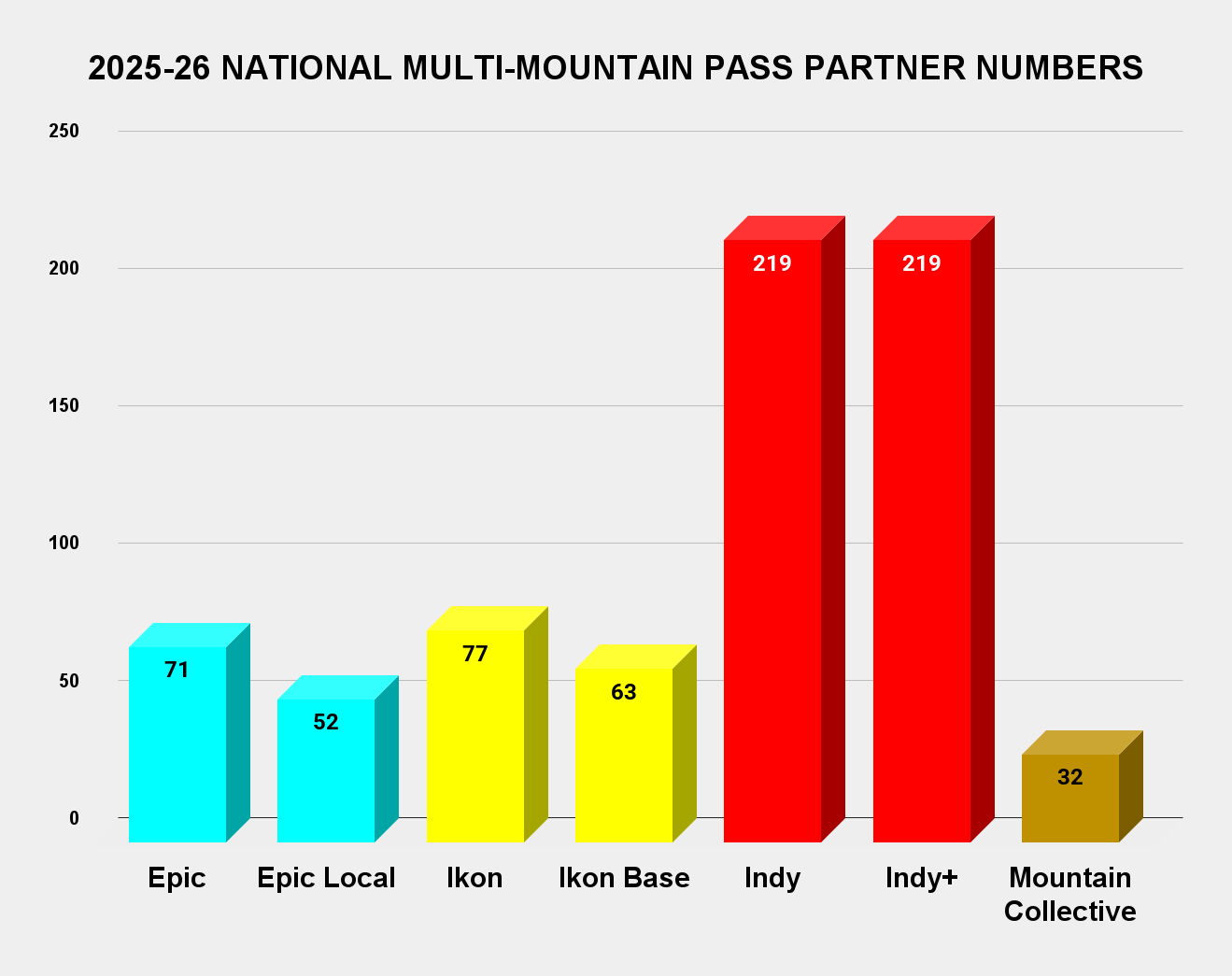
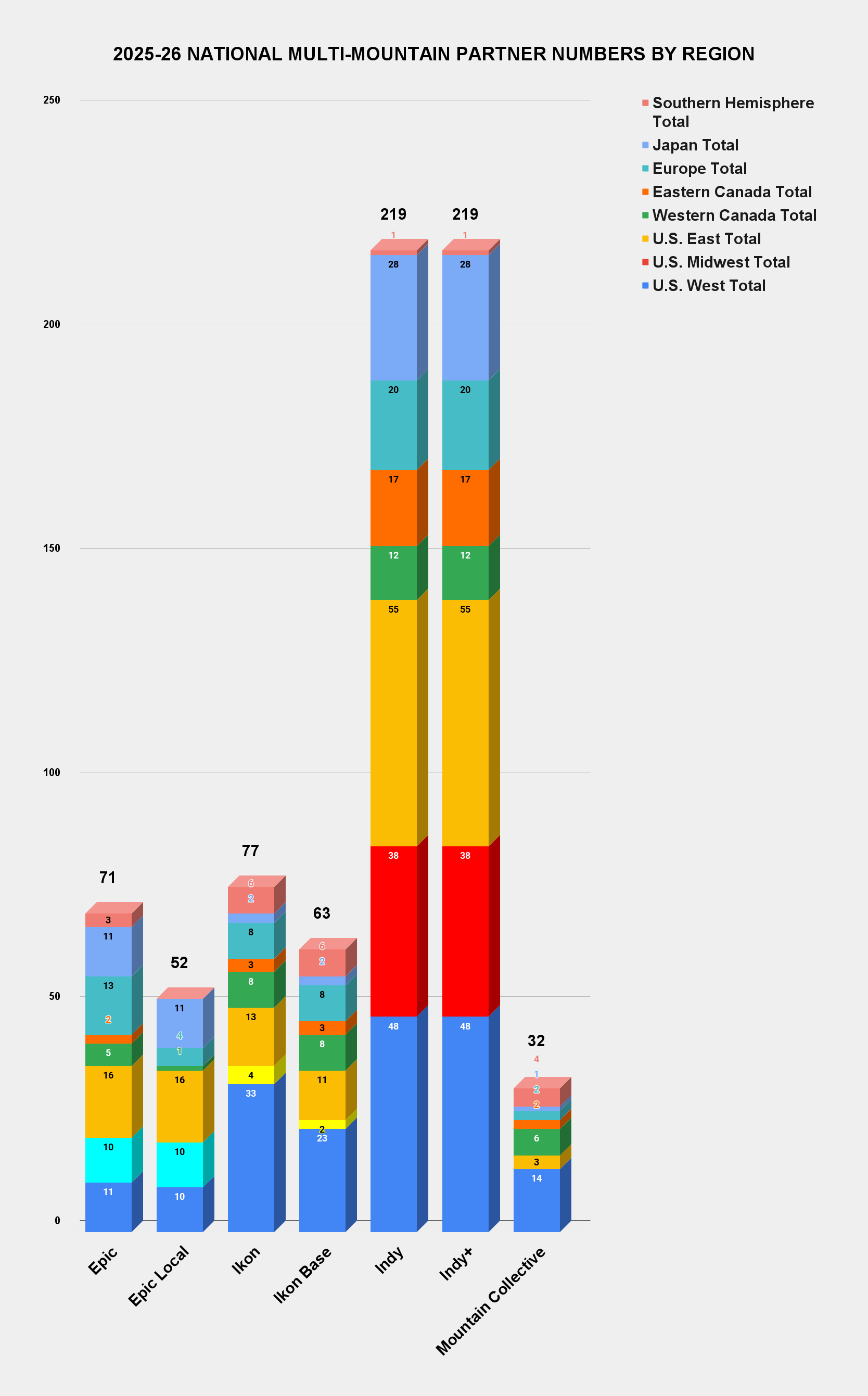



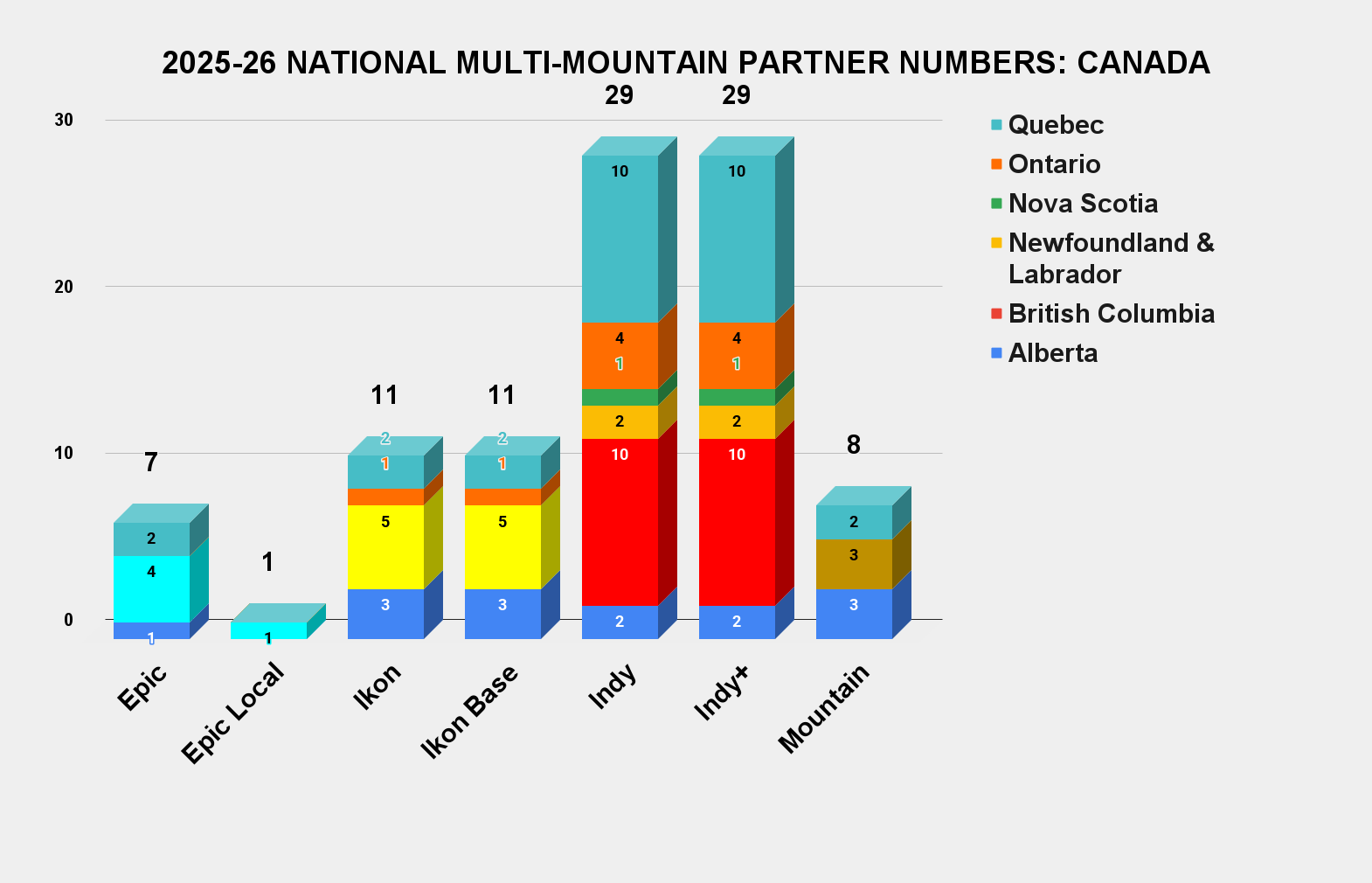


Excellent and very helpful analysis. You've done the math for all of us!
Love the charts. Can never get enough of them. But shouldn't the Indy and Indy+ bars be reversed to match the high-low sequencing that you used for both Epic and Ikon?